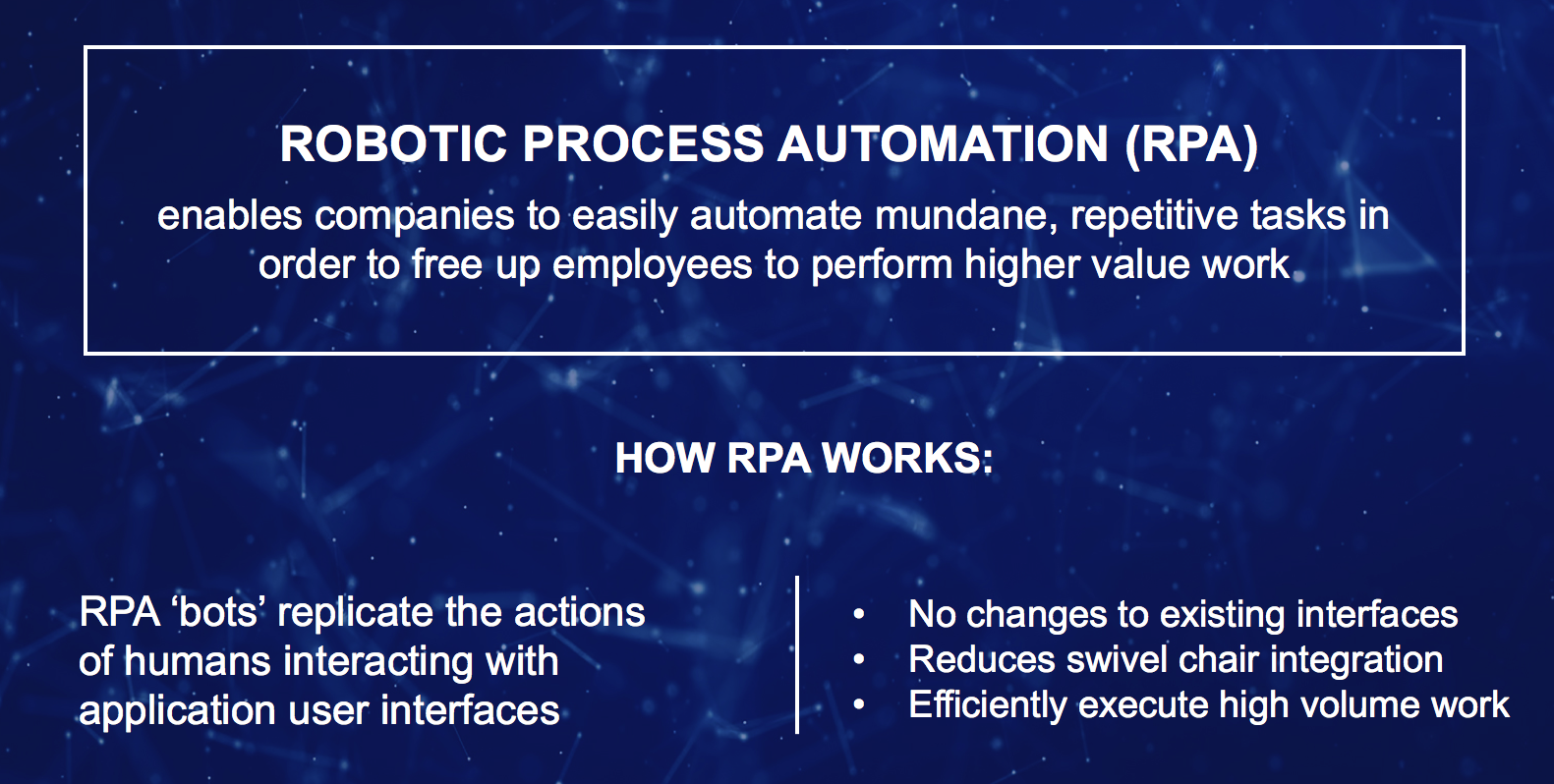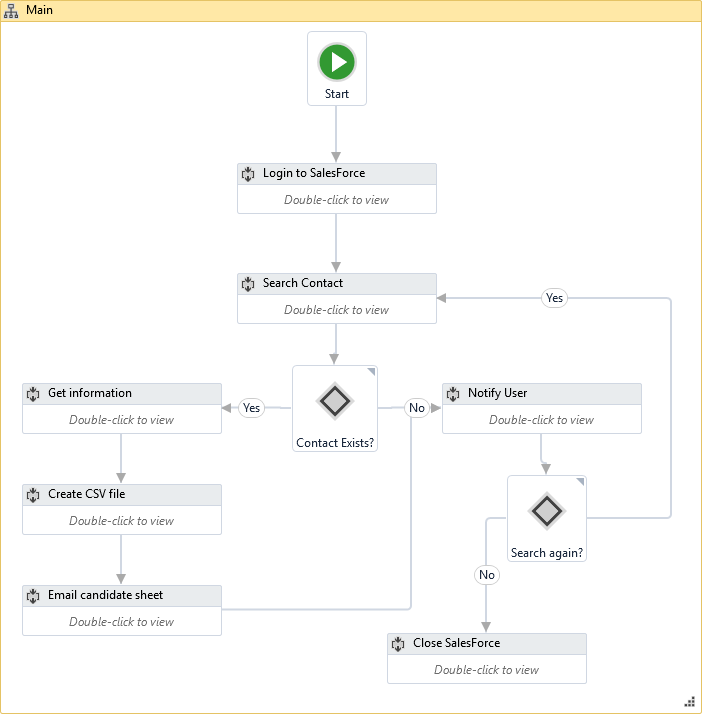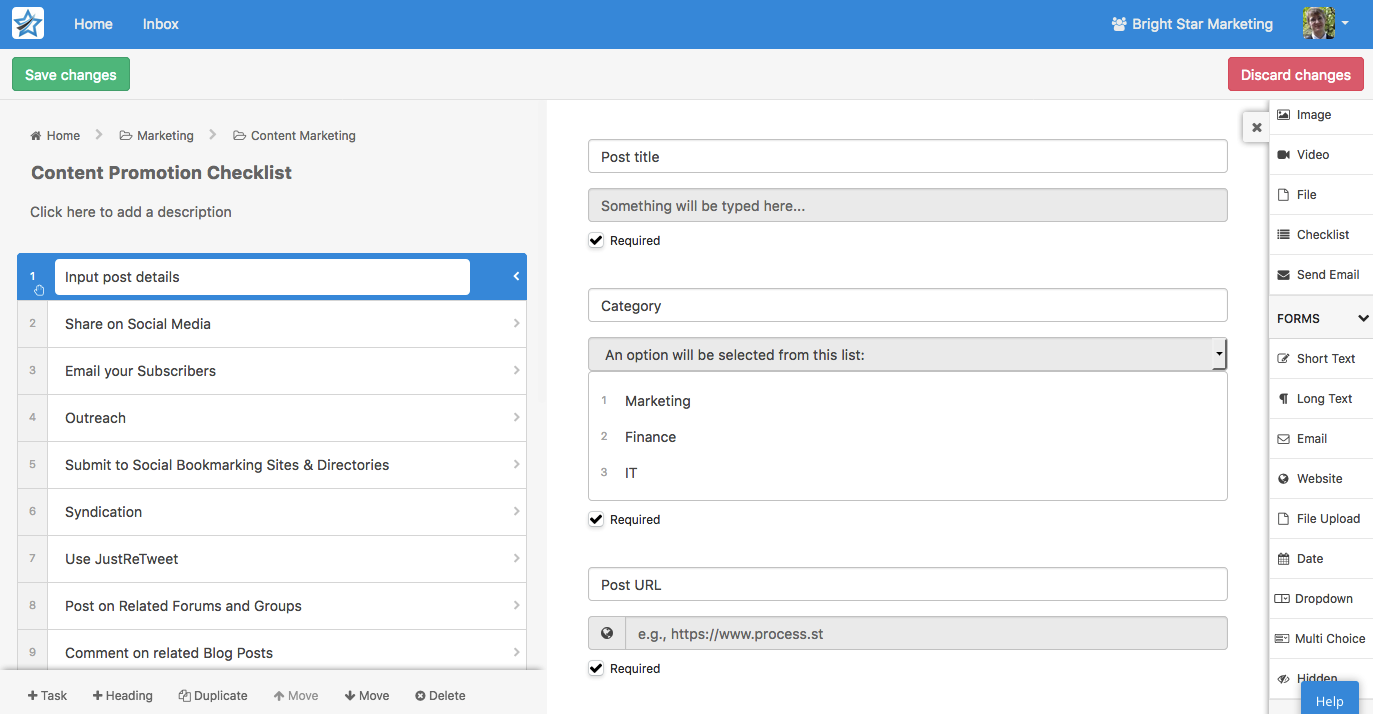
In 2014 an employee at Xchanging named Amanda Barnes created a software robot she called “Poppy”.
Poppy’s job was to help automate the tedious task of validating insurance premiums — something which could be easily done by a computer if it was fed structured data.
Before Xchanging built Poppy the robot, they were processing 500 premiums every few days. With Poppy, the same 500 items take just 30 minutes to process.
Rather than kicking Poppy out of the office in case she starts taking jobs, the Xchanging team welcomed her warmly because she saved them from laborious, mechanical work.

According to Harvard Business Review, robotic process automation implementations like Poppy are often welcome because they free knowledge workers from tedious tasks:
“Knowledge workers consistently tell us they want to be liberated from such highly-structured, routine, and dreary tasks to focus on more interesting work. Some are actually getting that wish, thanks to a new approach known as Robotic Process Automation (RPA).”
Artificial intelligence has a long way to go before it can make the kinds of complex decisions as humans and the modern workplace does still rely on people interfacing with software to get most of its work done.
This is a big leap from the business that relied on rolodexes, local spreadsheets, and fax machines — it’s a business that runs on data, SaaS, and teams of people trained to get insights from these assets.
But, with that comes a problem.
Technology is both empowering and complex: CRMs automatically keep track of your sales activity and make it visible to your whole team, but they also need arduous, time-wasting upkeep. Exports from SEO tools can give vital marketing insights, but the data need standardizing, re-formatting, and merging with larger sets before it’s useful.
All of these tasks combine to leave knowledge workers spending more time on robotic data entry tasks than they spend on work that takes full advantage of the skills they were hired for.
In fact, salespeople spend more time on tasks that could be automated than they do selling:

The fact that a task can be automated doesn’t always mean a business will invest the time or money necessary to automate it. Until recently, that was because they didn’t have the right tools for the job, or because the solutions were designed for huge businesses with infinite IT resources.
Now, with robotic process automation, the tools to automate the tasks that kill employee motivation and waste company time are cheaper, code-free, and in the hands of the employees themselves.
In this article, we’ll look at the rise of robotic process automation, how it’s impacted the early adopters, and the tools you can get started with.
What is robotic process automation (RPA)?

Before we get into the specifics of RPA, let’s just look for a moment at automation in general. Automation typically helps with two key areas of business process execution:
- To integrate IT systems that don’t always talk to each other — different SaaS, desktop software, and computers, for example
- To do work that is too time consuming for humans
In the past, automation has been the responsibility of your IT department. They’re responsible for working with APIs to build integrations, and writing automation scripts for teams. Zapier and other API-based middleware has solved this issue for many common use cases, but these tools do have their limitations with regard to which software and actions are supported.

It’s still early days, but some sources argue that Zapier is a flavor of RPA. The way it works (“for each [trigger], do [action]”) allows teams to build workflow rules that run in the background, like “for each new email with a finance report attachment, save it to a shared Google Drive folder”.
But typically RPA transcends the web, and it doesn’t rely on being fed trigger information. The user themselves can trigger a robot on a spreadsheet column or folder of documents, for example, to process them according to rules like shown below in this screenshot from UiPath’s workflow builder:

Some solutions can even learn processes from watching what the user does, and then use their execution to create a kind of ‘template’ that can be filled with constant variables and applied to the task next time, even if some elements have been renamed or moved.
It’s different to automation in the sense we usually talk about it because it doesn’t depend on code, or an API. The robot’s tasks can be chained together into a flowchart, which is something most professionals will be familiar with.
So, instead of getting the IT department involved, or building custom integrations, RPA is a way to empower (non-technical) employees to create and edit their own automations on the fly, as and when needed.
When creating robots, users don’t interact with hidden layers of the software like someone might if they were working with an API. The actions available to the robot are the same as actions available to the human — click here, type this, apply a formula to these cells — but automated, and much faster!
With the right planning and testing, employees can build their own robots to automate manual tasks that consist of things like data entry, data validation, filtering, copy/pasting, managing files and documents, etc. Wave CRM upkeep goodbye.
How RPA can save your business time and money
RPA hands the laborious work over to an always-on, perfectly precise machine, freeing up time for skilled employees to do what they do best. Designers can design instead of arranging meetings, and salespeople can sell instead of combing through spreadsheet data. The employee satisfaction boost that comes with more freedom can’t be quantified, but automation’s cost-cutting power can:
“In one case study we saw UK mobile communications provider Telefónica O2 deploy more than 160 robots to process between 400,000 and 500,000 transactions each month, yielding a three-year return on investment of over 650%” — Blue Prism
This case study proves that automation works at scale in enterprise settings — O2 automated 160 different tasks that would otherwise require up to 500,000 instances of human interaction.
To give you an idea as to what that looks like in terms of cost cutting, Deloitte reports that a cost reduction of 30% per process is typical. Cognizant, an American IT services corporation, reports that it saved 44% of the costs related to processing insurance claims by handing the task off to a software robot.

Through the lens of a corporation’s employees, cutting costs by 44% might sound like something that would cause mass layoffs, but the effects have been surprising. In a study, Harvard Business Review reported that most RPA adopters promise their employees that their jobs aren’t at risk, and that has led workers to feel unthreatened by their robot assistants, some of which like Poppy have been given human character by affectionate teams.
Rather than killing jobs, automation in this sense helps knowledge workers scale up their data processing ability to match the growing supply of data collected by modern business intelligence tools — it’s a way to hand off the robotic, eye-glazing work to a bot and focus on something more human and interesting.
“Combining these technologies, human knowledge workers might soon, in the midst of creative tasks, call on multi-tasking robotic coworkers to perform supporting work as needed — boosting their output even in novel processes with “robots-on-request.”
Four key tools for robotic process automation
Process Street

Process Street is a powerful workflow tool for teams which works especially well as a control panel for your automated sequences. Processes in Process Street are represented as checklists, and with our Zapier integration, you can connect each checkbox to actions in other apps.
As your team works through the process, integrations do the boring work in the background, like updating your company records, or sending formulaic emails.
This is a great way to build the functionality of robotic process automation into processes that need human intervention — for example, creating and sending a sales proposal to a new customer can largely be automated, but might need a human to come and check off the “approved” step after validating it.
Below is an example of Process Street integrated with HelloSign and a CRM to form a powerful automated sales proposal process:
What’s more, with conditional logic you can create processes with multiple branches that appear depending on variables. For example, if the form fields indicate that a logo is required in the design process, Process Street can show all tasks related to logo design:

Process Street users on the free plan can take advantage of our integrations with 1,000+ apps today — sign up, and start building the automated processes your business needs.
Roro
Roro is a free and open source tool for Windows 10 and Windows Server. It provides a free taste of RPA without the power that would come with a powerful, expensive cloud-based solution.
Roro works on the same level as the human user, with access to the command line and keyboard. It can perform a series of actions chained together in a flow chart, a lot like the native Automator app on MacOS, but wouldn’t be able to access APIs and trigger sequences like Zapier.
UiPath

As well as offering a fully-featured enterprise edition, UiPath provides a free version of their RPA suite to individuals and small businesses.
The major limitation is that the free Community Edition doesn’t include Orchestrator, a cloud server users can use to control and deploy robots on a large scale.
Still, if you’re looking for a free tool without sacrificing too much power, the UiPath Community Edition is a great choice for creating automated workflows, with a deep integration with Citrix products.
IBM RPA + Watson

IBM’s robotic process automation solution comes in two halves: a feature for a worker to record workflows, and a dashboard for admins to control the active workflows and generate reports. These features are quite typical for enterprise RPA, but IBM’s solution really comes into its own thanks to its integration with Watson.
With Watson, tasks that required human analysis and input because they were variable or complex can now be automated. In the words of IBM, Watson can:
- Understand natural language, structured and unstructured data
- Generate and evaluate hypothesis’ for better outcomes
- Adapt and learn from user selections and responses
This effectively means that you’re teaching an always-on analysis engine how you work so you can train the software how to do the task automatically.
The benefits of robotic process automation are clear for early adopters, but we still can’t fathom how intelligent and automated the businesses of the future will be. How long will it be before most offices are equipped with a central AI supercomputer? Will everyone’s job including building and maintaining software robots? Let me know your experiences and predictions in the comments.







Benjamin Brandall
Benjamin Brandall is a content marketer at Process Street.